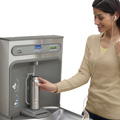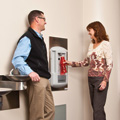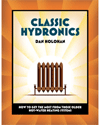
Travelers passing through Terminal 2 atChicago’s O’Hare International Airportwill notice the sink that stands in the middle of the floor just before the security checkpoint.
That sink allows passengers to discard liquids prior to passing through security - keeping in check with federal aviation regulations.
“It’s a sink with no faucet,” explainsViva White, the head plumber at O’Hare. “All that was involved was running a drain and a p-trap and making sure the p-trap has some water in it.”
However, after passing through security, those passengers who had to discard liquids from their containers can get a quick refill of water thanks to the installation of twoElkay EZH2O bottle-filling stationsbetween gates E1 and E2.
The practice of installing bottle-filling stations in commercial properties is gaining in popularity, with more and more building operators embracing the push for greater sustainability practices.
In the case of O’Hare, making the decision to go the bottle-filling station route stemmed not only from environmental considerations, but with its maintenance staff in mind as well.
“The weight of the garbage is tough on the custodians,” White says. “People are throwing away full bottles of water. Some people are not aware and then get to security and find out they cannot take a beverage through security. Full 12-ounce bottles add up quickly.”
White also was pleased with the ability to retrofit the new bottle-filling units with the existing Elkay drinking fountains in the terminal. One station was installed at standard height and one at ADA-sanctioned height.
“It worked out perfectly for us,” she says. “We just put them on top of the existing fountains. There is a water line coming down through the faucet. We were able to tap into the existing water line.”
O’Hare is not the only airport going to bottle-filling stations. ThePort Columbus (Ohio) International Airportinstalled anOasis VersaFillerunit in Terminal A on a trial basis.
“We introduced the VersaFiller about two years ago and it has really started to pick up momentum,” says Oasis Vice President of EngineeringLou Busick, who adds the VersaFiller is compatible with a number of different manufacturers’ water coolers. “It can go on top of an existing water cooler, so there is no extra plumbing needed to install it.”
With no electrical requirement, the VersaFiller provides running water even when the power is out.
“Users save money and time on installation because there is no plumbing and no electricity to consider,” Busick notes.

Schools Get Their Fill
A pair of West Virginia colleges used funding from green programs to install Oasis VersaFiller stations. Oasis bottle-filling stations are in a host of colleges and universities throughout the country.Marshall University in Huntington, W.Va., launched a sustainability department in late 2009. One of sustainability managerMargie Phillips’ first goals was to reduce the number of plastic water bottles discarded on campus.
“The department did a reusable bottle giveaway and the students really liked the bottles,” she says. “We installed the Oasis bottle-filling stations throughout campus so students could utilize their bottles. The whole student body initially received the reusable bottles, and then we gave them away to faculty and staff.”
The bottle-filling stations were purchased using funds from the school’s Student Green Fee. In 2008 students voted to include the $5 annual fee in their tuition. The funding from the fee is utilized for student recycler wages, bike mechanic wages and green initiatives on campus. Marshall installed 16 VersaFiller stations and an additional 10 or 12 are budgeted for future installation.
“The campus community asks for bottle-filling stations and uses them,” Phillips says. “We included them in the budget to install more every year until our goal to have one on every academic, residential and administrative office floor is accomplished.”
In addition to the bottle-filling stations, low-flow faucets, low-flow urinals and dual-flush toilets add to Marshall’s green footprint.
AtWest Virginia Wesleyan Collegein Buckhannon, a similar sustainability push is well underway. The school installed five VersaFiller stations - four coming thanks to grant money from Enterprise Holdings in support of a student-led, campus-wide plastic water-bottle reduction initiative and cooperation from Oasis.
“I don’t think the students were aware of these stations before,” director of community engagementLeeAnn Brownstates. “When I showed some students the units, it was: ‘Wow. We need those.’ It was instant recognition and enthusiasm. We already had a movement going toward plastic water-bottle reduction. The students supported and pushed for these. They love them. There is one in our gym and you can see the cross-country runners lining up and filling their bottles. It’s super-utilized.”
Brown’s goal is to have one installed in each residence hall.
A Piece Of The Green Puzzle
TheHSBC Bank Canadabuilding in Burnaby, British Columbia, has earned a LEED Platinum rating for its shell and a LEED Gold rating for its inside contents.In addition to Kohler waterless urinals, Delta low-flow showerheads, Stiebel Eltron shower valves, the use of recycled rainwater to flush Duravit low-flow toilets and Noritz tankless water heaters to heat the cafeteria, the building installed two Haws Brita Hydration Stations in the 160,000-square-foot facility earlier this year.
“There was a large demand for it,” senior facility managerLuc Cronierstates. “We have a gym onsite and didn’t have anything for drinking water supply. When the cafeteria closed, there was no source for water. We have 1,000 people in this building plus 300 next door that have access to the building. It’s been well-used.”
The Haws Brita system features a bottle counter, which shows users how many plastic water bottles are saved.
“On average, we fill 200 bottles a day,” Cronier says. “We have saved a big number of plastic bottles.”
The results at O’Hare in Chicago have been just as impressive. Elkay’s EZH2O features a Green Ticker that displays how many 16-ounce bottles have been filled using that unit. Data from the two stations shows O’Hare has saved more than 200,000 plastic bottles since installation last year.
“We’re helping out the environment,” White says.

